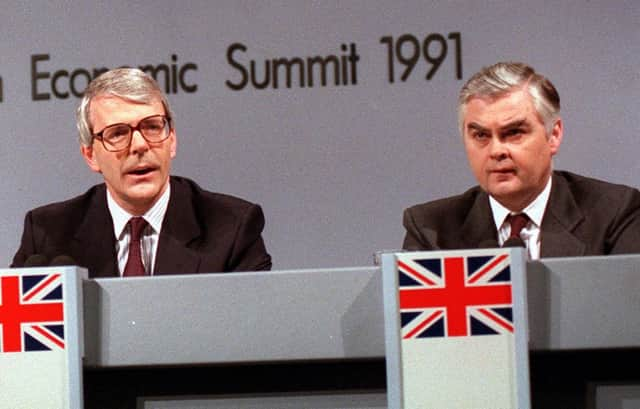Secret panic as No10 propped up the pound


The political agenda that day – Black Wednesday, September 16, 1992 – should have been set in Harrogate, where the Liberal Democrats were winding up their annual conference.
Instead, it saw the Prime Minister and his Chancellor having to withdraw the pound from the European Exchange Rate Mechanism because it could no longer trade above its minimum limit.
Advertisement
Hide AdAdvertisement
Hide AdBehind the scenes, the Government was engaged in a frantic and secretive attempt to mitigate the effects of the deal, using a process to which officials referred as “creaming off”, papers released by the National Archives reveal.
Black Wednesday was a stunning humiliation for John Major, who, as Chancellor, had taken the pound into the ERM two years earlier, against the wishes of his predecessor, Margaret Thatcher.
But it quickly fell victim to speculators whose target was a monetary union they thought would never work.
By September 16, the selling of sterling was so intense that the Bank of England was having to buy it back at £2bn an hour.
Advertisement
Hide AdAdvertisement
Hide AdAs the pound crashed out of the ERM, the new Chancellor, Norman Lamont, was under fierce pressure to say how much of Britain’s foreign currency reserves had been used in the failed bid to shore it up.
Publicly, he insisted that no government would reveal such information, but the archived papers show that behind the scenes, he was “increasingly anxious” about the way the true state of the reserves was being concealed.
The final cost of the operation was estimated at £3.3 bn.
But while it instantly transformed the position of the reserves – from $18bn in credit to $16m in the red – the official figures at the time showed only a “minimal” loss of $2bn.
The details of what exactly happened are spelled out in a letter to No 10 from Mr Lamont’s private secretary Jeremy Heywood, now the Cabinet Secretary, setting out the Chancellor’s strategy for rebuilding the reserves.
Advertisement
Hide AdAdvertisement
Hide AdHe said the government had been able to disguise the amount of additional borrowing required, in part through the creation of what was described as a “secret negative forward book”, to re-acquire foreign exchange through “forward swaps” worth around $12.5bn.
However, once the crisis was over, the clandestine manner in which the operation was conducted meant the only way of running down the forward book was through a “non-publicised” programme of using sterling to buy back foreign currency – a process known as “creaming off”.
The letter reads: “In principle the forward book could be run down either by public borrowing or lower gross reserves; but having consciously disguised this part of the September’s operations it would now be very difficult to explain the real reason why we were now undertaking further borrowing or revealing lower gross reserves.
“That points to non-publicised ‘creaming off’ as the only acceptable approach.”
Advertisement
Hide AdAdvertisement
Hide AdThe letter notes that the Bank was “very cautious” about the tactic fearing it could lead to further falls in the pound.
In an accompanying memo, Mary Francis in the No 10 private office notes that Mr Lamont was “increasingly anxious about the way it is being used to conceal the actual state of the reserves.”